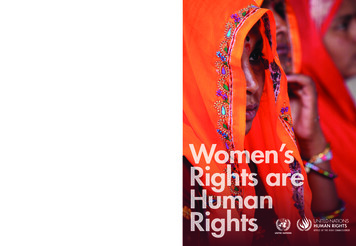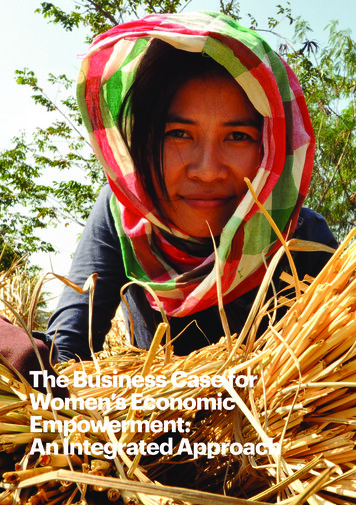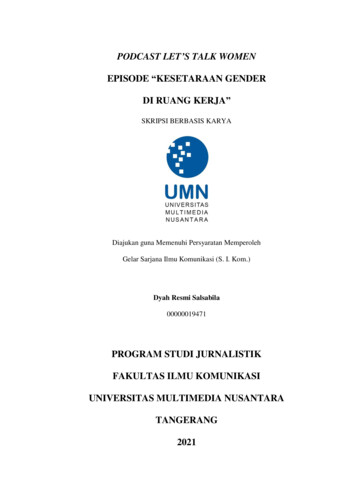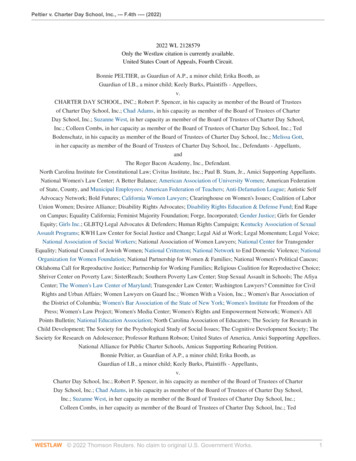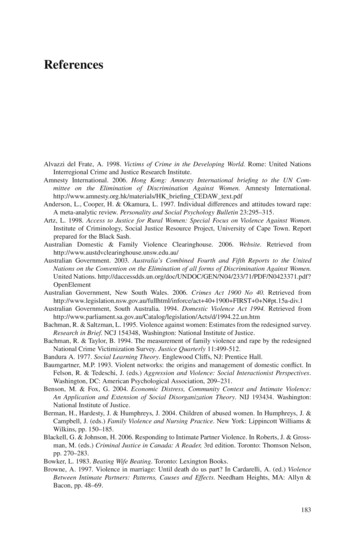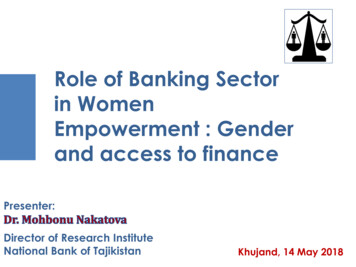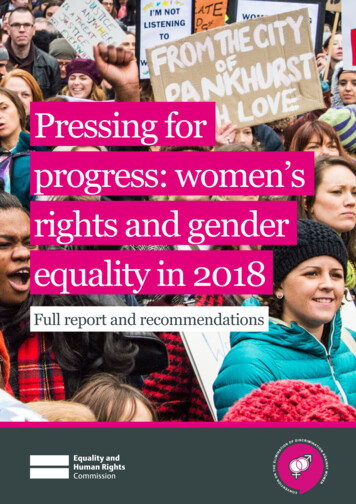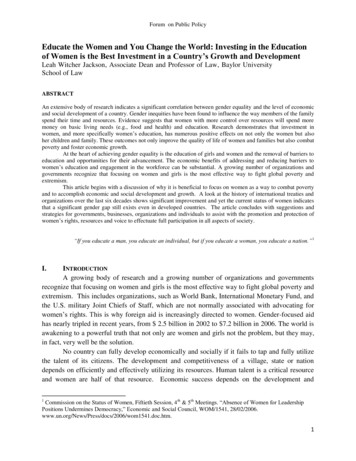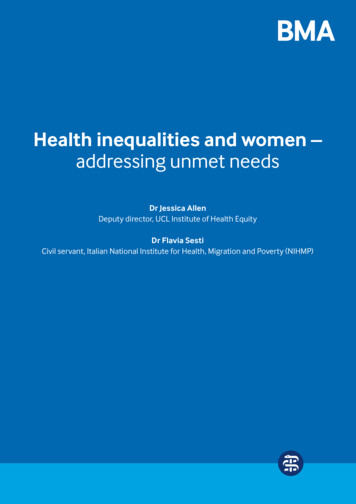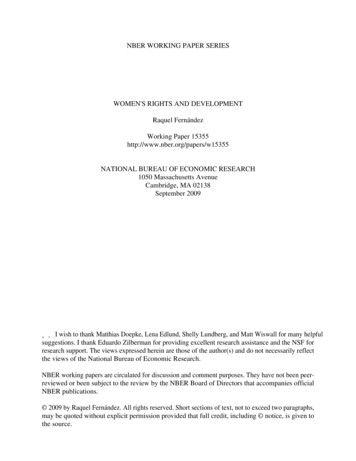
Transcription
NBER WORKING PAPER SERIESWOMEN'S RIGHTS AND DEVELOPMENTRaquel FernándezWorking Paper 15355http://www.nber.org/papers/w15355NATIONAL BUREAU OF ECONOMIC RESEARCH1050 Massachusetts AvenueCambridge, MA 02138September 2009 I wish to thank Matthias Doepke, Lena Edlund, Shelly Lundberg, and Matt Wiswall for many helpfulsuggestions. I thank Eduardo Zilberman for providing excellent research assistance and the NSF forresearch support. The views expressed herein are those of the author(s) and do not necessarily reflectthe views of the National Bureau of Economic Research.NBER working papers are circulated for discussion and comment purposes. They have not been peerreviewed or been subject to the review by the NBER Board of Directors that accompanies officialNBER publications. 2009 by Raquel Fernández. All rights reserved. Short sections of text, not to exceed two paragraphs,may be quoted without explicit permission provided that full credit, including notice, is given tothe source.
Women's Rights and DevelopmentRaquel FernándezNBER Working Paper No. 15355September 2009JEL No. J12,J16,N31,O15,O16ABSTRACTWhy has the expansion of women's economic and political rights coincided with economic development?This paper investigates this question, focusing on a key economic right for women: property rights.The basic hypothesis is that the process of development (i.e., capital accumulation and declining fertility)exacerbated the tension in men's conflicting interests as husbands versus fathers, ultimately resolvingthem in favor of the latter. As husbands, men stood to gain from their privileged position in a patriarchalworld whereas, as fathers, they were hurt by a system that afforded few rights to their daughters. Themodel predicts that declining fertility would hasten reform of women's property rights whereas legalsystems that were initially more favorable to women would delay them. The theoretical relationshipbetween capital and the relative attractiveness of reform is non-monotonic but growth inevitably leadsto reform. I explore the empirical validity of the theoretical predictions by using cross-state variationin the US in the timing of married women obtaining property and earning rights between 1850 and1920.Raquel FernándezDepartment of EconomicsNew York University19 West 4th Street, 6th FloorNew York, NY 10012and NBERraquel.fernandez@nyu.edu
1IntroductionThe last two hundred years have witnessed a substantial, historically unprecedented, expansionof women’s rights, both economic and political. In almost all industrialized countries, womenwent from being the property of their husbands and/or their fathers, with very few legal rights,to possessing the same political rights and most of the same economic rights as men.1 Whydid this process occur? And, in particular, why is the spread of women’s rights across theglobe appear to be correlated with economic development?2The objective of this paper is to shed light on the relationship between women’s rights anddevelopment by focussing on a fundamental economic right: property rights. Property rightsinclude “the legal rights to acquire, own, sell and transfer property, collect and keep rents,keep one’s wages, make contracts, bring lawsuits, and, if seeking divorce, maintain some of themarriage assets and keep control and guardianship of the children.”3 These are rights thatmarried women did not exercise in full neither in Europe nor in the US until the legal systemwas reformed over a long period of time. Under most legal systems (e.g. the those basedon Roman civil law, which in‡uenced most of continental Europe, or those based on Englishcommon law, like the majority of US colonies), women who married lost, if not ownershipthen, at a minimum, control over their physical (inanimate) property and, upon divorce, lostguardianship over their children as well.Why did married women eventually obtain property rights in the US and in Europe?4 Whydid men lose some of the advantages of their privileged status? It is di cult to nd a rigorousargument for this in the historical literature.5 This paper examines the hypothesis that, overtime, economic development – by which I mean primarily a process of capital accumulationand declining fertility – altered male interests regarding women’s rights. That is, althoughmen in general bene tted from a patriarchal society in which women enjoyed few economicand political rights, they also su ered from the welfare consequences of such a system for theirdaughters. My hypothesis is that, at a su ciently high level of wealth and/or at a su cientlylow level of fertility, a man’s con‡icting interests in his role as a husband relative to those inhis capacity as a father were resolved in favor of the latter. This argument is examined ina dynamic model and its implications are studied empirically by using variation across USstates in the timing of married women’s property acts.The theoretical argument is developed in the context of a OLG economy with endogenous1This process is far from complete globally as is clear from various indices of gender equality (see.e.g.the The Global Gender Gap Report 2007). See Du‡o (2005) for a review of the literature on gender anddevelopment.2Indices that measure women’s (lack of) rights in areas as diverse as access to land, access to bank loans,violence against women, abortion policy, etc., show a robust negative correlation across countries with GDPper capita. See Doepke and Tertilt (2009).3See http://www.womeninworldhistory.com.4Women today do not enjoy full property rights in several parts of the world, both de jure and de facto.5A variety of arguments are given (see the literature review that follows below), but there are no comparativestudies, to my knowledge, that try to make the case for the importance of some factors over others.1
growth in which parents care about their own utility from consumption and the average welfareof their children. In this economy, individuals marry and have children. They then produce,consume, and bequeath capital to (or invest in) their children. Under a patriarchal systemin which married women have no property rights (also denoted the "no rights" regime), theallocation decisions are made entirely by the husband and he obtains, loosely speaking, allthe surplus from the marriage. In an economy where women have the same property rightsas men (also known at the "equal property rights" regime), the allocation weighs the welfareof both spouses equally.The theory yields three central predictions. First, it predicts that growth will eventuallylead men to prefer the equal rights regime over the patriarchal one. Male preferences over thetwo regimes will not be, however, a monotonic function of wealth (or capital stock). Startingat a low level of wealth, greater wealth rst increases the relative attractiveness of the norights regime. Once wealth is above some critical threshold, further increases will decreasethe attractiveness of the patriarchal system. Second, the theory predicts that lower fertilitywill lead to earlier regime change. Thus, ceteris paribus, states with lower fertility shouldreform their property regime sooner. Third, it predicts that states with legal regimes that areinitially more favorable to married women, perhaps surprisingly, should see property rightsreform happen later.The main intuition delivered by the model relies on the asymmetric e ect that growingwealth or falling fertility has on the welfare of sons versus daughters. Under the patriarchalregime, both factors improve the welfare of sons more than the welfare of daughters. Inparticular, falling fertility enables a father to increase his son’s welfare by bequeathing moreto him. His ability to increase the welfare of his daughter via greater bequests, on the otherhand, is more limited since the surplus from marriage is captured primarily by his son-in-law.As fertility decreases, the disparity in welfare enjoyed by sons versus daughters increases,exacerbating the welfare cost of the patriarchal regime relative to a system of equal propertyrights. At some critical level of fertility, a father is made better o sacri cing the consumptionbene ts he obtains from being sel sh with his wife in order to ensure that his sons-in-lawsare forced to be generous towards his daughters. The intuition for why growth eventuallyleads to regime change is similar except that it is complicated by the nding that the relativebene t of the two regimes is not a monotonic function of wealth.The empirical investigation uses variation across US states in the timing of property rightsreform and other key variables. Beginning in the 1840s, US states and territories reformedthe laws governing married women’s ownership and control of (real and personal) propertyand earnings. I use Geddes and Lueck’s (2002) dating for when a property act gave womenmanagement and control of their separate estate and similarly for earnings. This was arelatively lengthy process beginning with Massachusetts in 1846 and (for the purposes of thisanalysis) ending with all but four out of 48 states having granted these rights by 1920.I show that two key predictions of the model are consistent with the empirical relationsfound in the data. In particular, I construct a measure of survival-fertility which considersonly children above the age of ten and thus guarantees that these would have a very highchance of surviving to the age of marriage – as these are the individuals that concerns thetheory. I show that, ceteris paribus, states with lower levels of survival-fertility tended to2
reform earlier. Since survival-fertility is an endogenous variable, I also instrument it withchild mortality. Ceteris paribus, states with higher child mortality tended to have lowerlevels of survival-fertility The results are robust to the use of this instrument. In addition, asimplied by the theory, I nd that states with a legal system that was relatively more favorableto women (those with a system of community law which decrees that property acquired duringmarriage and the pro ts derived from it are jointly owned by both spouses) tended to reformtheir property laws later. The e ect of per-capita wealth, on the other hand, is almost alwaysinsigni cant and close to zero.6 All the results are robust to year and state (or regional) xede ects.The paper is organized as follows. The next section presents a literature review of the mainwork in this area followed by some historical background on married women’s property rightsin the US in the 1800s. Section 3 presents the model, derives the main theoretical results,and discusses the roles of the various assumptions and extensions of the model. Section 4examines the empirical evidence regarding the relationship between women’s property lawsbetween 1850-1920 in the US and state levels of per-capita wealth, survival-fertility, anddi erent legal systems using a variety of estimation methods. Section 5 concludes.2Literature and HistoryIn this section I present a review of the literature in this area and a brief historical overviewof married women’s property rights.2.1Literature ReviewThere is a growing literature that investigates why rights were extended to various segmentsof society. The general idea that an elite may give up some of its privileges to improve its ownwelfare can be found in several contexts. The literature on franchise extension (see the reviewby Przeworski (2006)) mostly argues that su rage rights were conceded because it became inthe self-interest of those in power for a variety of reasons unrelated to the one developed inthis paper (see, e.g., Justman and Gradstein (1999), Lizzeri and Persico (2004), Llavador andOxoby (2005), or Ticchi and Vindigni (2006)), although there are also papers that focus on thethreats of revolution or violence (see, e.g., Acemoglu and Robinson (2000) or Jack and Laguno (2003)). For the interesting case of women’s su rage, a recent paper by Bertocchi (2008)develops the hypothesis that men granted women the vote once industrialization and theensuing narrower gender wage-gap rendered gender preferences over taxation more similar.7Whether slavery was abolished because it was ine cient and thus no longer in the interests ofland-owners has also been debated (see, e.g. Fogel and Engerman (1974) or Wright (2006)).Other rights, such as education or the prohibition of child labor, have also been studied.Galor and Moav (2006), for example, develop the thesis that educational reform (universalpublic education) was in the interest of both capitalists and workers and Doepke and Zilibotti67In the section on discussion and extensions, a potential explanation for this is suggested.See, e.g., Edlund and Pande (2002) for evidence on the existence of a gender gap in voting behavior.3
(2005) argue that child labor laws (forbidding the latter from working) were in the interest ofworking families.The two papers that have investigated why women obtained economic rights –Geddes andLueck (2002) and Doepke and Tertilt (2009) –also start from the premise that men grantedwomen economic rights because it was in the former’s self interest. Geddes’ and Lueck’stheoretical reasoning is essentially the same as the economic argument made for the abolitionof slavery: they argue that married women’s inability to own and control property (includingearnings) produced suboptimal e ort on their part and that this ine ciency increased withgreater capital. The fact that white married women in the US during the second half of the1800s did not work outside the home makes this argument less persuasive, however.8 Themain contribution of their paper, however, lies in its use of variation in the timing of whenUS states granted married women the right to own and control separate estates and earningsto examine the implications of their theory. They nd a robust positive relationship betweenper-capita wealth and a state’s reform of its property rights laws. Their paper, and an earlierstudy by Kahn (1996) that investigated the e ect of these reforms on women’s patentingactivity, deserve credit for making use of this variation to study the causes and consequencesof these fundamental reforms. The empirical portion of my paper build on these importantcontributions.Doepke and Tertilt (2009) present a very interesting theoretical analysis regarding women’seconomic rights that relies on two key ingredients: ine cient investment in children andgender di erences in preferences. They assume that the marriage market matches peoplepurely at random and that children are public goods. This necessarily leads to ine cientlylow investment in children (in their case, in the form of human capital), as there is no "price"mechanism (i.e. no competition) that allows the marriage market to internalize the utility ofthe child’s future spouse from higher investment. This is a standard result in the marriageliterature. The twist comes from the assumption that women discount the welfare of theirchildren less than men. This implies that if the return to time spent educating children issu ciently high, men will be made better o allowing women to have a greater say in decidinga child’s level of education as this goes some way towards remedying the ine ciency. Theauthors interpret this result as increasing the incentives that men had to grant women greatereconomic rights as this presumably would increase the latter’s bargaining power and thus theirability to in‡uence household decisions. A possible objection, however, is that if this werethe main reason to extend rights, it would have been easier and more advantageous for mento simply mandate a higher level of education for all (i.e., compulsory schooling, which in factalso happened over this time period).9The argument developed in my paper does not require ine ciencies arising either from production or from the marriage market nor rely on exogenous gender di erences in preferences,which is not to say that these factors did not play a role in the extension of women’s rights.8As calculated in Fernández (2008), for example, in 1880 the labor force participation of white marriedwomen in the US between the ages of 30-40 was below 3% and rose very slowly over the following 4-5 decades.See also Goldin (1990).9The authors are aware of this and develop an extension of their model in which parents and schools arecomplements in the production of human capital. In this extension, an increase in the return to human capitalcan make increasing both inputs more attractive.4
Instead, it rests upon fathers caring about their daughters’welfare and their inability to makethe latter better o except indirectly (by bequeathing more and thus increasing the welfare oftheir grandchildren, i.e., their daughters’children). It is reassuring, therefore, for the mechanism proposed by this paper that there exists recent evidence showing that daughters appearto in‡uence fathers’ legal and political preferences.10 In particular, two interesting recentpapers (Washington (2008) and Oswald and Podthavee (2006)) show that voting preferencesand behavior are in‡uenced by the proportion of one’s children that are girls.Washington (2008) uses voting records from the US Congress in 1997-98 and nds that,conditional on the total number of children, a US Congressional Representative is more likelyto vote liberally on women’s issues the greater the proportion of female children. Oswald andPodthavee (2006) use the British Household Panel Study data to examine preferences towardspolitical parties in the UK. They nd that, for a constant family size, parents with more girlshave more "left" wing preferences (i.e., are more likely to identify with voting for either theLabor or Liberal Party). In the model presented here, it will also be the case that a fatherwith more daughters would, ceteris paribus, show a greater preference for women’s rights.112.2Married Women’s Property Laws in 19th century USThe British colonies based their laws on English common law which, as summarized in theBlackstone Commentaries, stated:By marriage, the husband and wife are one person in law: that is, the verybeing or legal existence of the woman is suspended during the marriage, or atleast is incorporated and consolidated into that of the husband; under whose wing,protection, and cover, she performs every thing; and is therefore called in our law-afeme-covert.12Under nineteenth century common law, a married woman was bound by the rules ofcoverture which, as seen above, vested her legal rights in her husband. Upon marriage, awoman’s personal possessions became her husband’s and he could dispose of them in anyway he wished during his lifetime or in his will. He was, in general, also entitled to all thepersonal property his wife might acquire during the marriage. Although her real propertyremained under her ownership, the pro ts from these went to the husband. Furthermore, thehusband had the right to manage her land. Thus, a husband controlled his wife’s propertyand earnings (whether from labor or from land). Furthermore, married women were notpermitted to enter into contracts without the consent of their husbands nor allowed to engagein trade on their own account as “sole traders”. Even children were allocated to their fatherin the (rare) case of divorce. After 1830, US states began to pass legislation that revisedthese restrictions. Between then and 1920 there was a large increase in women’s rights.1310See also Lundberg (2005) for an excellent review of the literature on sons, daughters, and parental preferences.11See the extension to a stochastic number of female relative to male children in Section 3.5.12From Blackstone (1765-69), Book 1, Chap. 15., p. 431.13See Doepke and Tertilt (2009) for a review of the expansion of some of these rights in the US and England.5
Some of the initial revisions of the law of coverture were in response to the Panic of 1837 andthe ensuing depression, particularly in the South.14 These laws mainly attempted to shielda married woman’s property (including slaves) from her husband’s creditors. This factordoes not explain why the laws evolved over time to allow women to own and control separateproperty, to write contracts, to own and control their earnings, or to maintain custody overtheir children. The excellent legal studies literature in this eld (e.g., Basch (1982), Chused(1983,1985), Salmon (1986), Shammas (2002), and Warbasse (1987)) discusses multiple causesthat range from the desire for codi cation, the growing awareness of the similarity in legalposition of slaves and married women, the greater status of women arising from their growingresponsibilities in the domestic sphere, the growing feminist movement, and paternalism.While these may have all played a role, an important question is why did they become criticalin the mid to late 1800s rather than earlier or later?Paternalism is the reason given for reform in this paper in the sense that men caring abouttheir daughters’ welfare is the key factor that, in combination with economic development,gives rise to women being granted property rights.15 In light of this, it is interesting to notethat in the popular rhetoric of this period, paternalism appears repeatedly. Legislators, forexample, would raise the “specter of drunken husbands”to gain passage of married women’sproperty acts. In Warbasse’s (1987) discussion of New York’s experience, she concludes:“Final passage became assured only when conservatives, convinced that a married women’sproperty acts held de nite bene ts for their own wives and daughters, dropped their talk ofseparate interests and family disharmony.”16 The contribution of this paper is to provide anexplanation for why paternal concern for a daughter’s welfare, presumably always present, nally overcame the bene ts associated with man’s privileged status in a patriarchal system.As will be shown, a process of capital accumulation and declining fertility eventually realigneda man’s interests to favor his daughter.3The ModelBelow I present a simple dynamic model and use it to study how growth, fertility, and legalregimes that are relatively more favorable to women a ect male preferences towards a patriarchal system relative to one in which women have equal property rights. I do not model theintricate legal system that governed the ability to bequeath, the inheritance rights in the caseof a spouse’s death (dower and curtesy), the di erences between the treatment of real andpersonal property, or the consequences of divorce. Instead, I simplify matters by assumingthat the issue is one of control over the allocation of the income derived from capital, whetherit is for consumption or for bequests. While this is a considerable abstraction, it hopefullyserves to clarify some of the basic implications of the two property systems.14Mississippi was the rst state to pass a married women’s property act in 1839.Furthermore, as will be made clear in section 3.5, the type of paternalism required by the theory isstraightforward. In particular, fathers need not care about their grandchildren via their daughter’s utilityfunction as in Doepke and Tertilt (2009) – it is su cient that they care about their daughter’s utility fromconsumption.16Warbasse (1987, p. 229).156
3.1The Basic FrameworkThe economy consists of married households composed of a man (the husband h), a woman(the wife w), and their 2n children (consisting of n boys and n girls). Throughout theanalysis I will keep fertility exogenous and examine how changes in its level a ect the relativeattractiveness of the two regimes.17Individuals have log preferences over the consumption good c and also care about theaverage welfare of their children. Maximization of a concave utility function implies thatall sons will obtain the same utility, Uh0 ; similarly, all daughters will obtain the same utility,Uw0 . The welfare of daughters relative to sons, however, will depend on the property rightsregime. Note that a prime 0 is used to denote variables for the next generation and thus thatUh , for example, is the husband’s utility whereas Uh0 is the utility of his son (himself a futureU 0 U 0nU 0 nU 0husband). The average welfare of children is thus h2n w h 2 w and an individual’sutility, Ui , can be written as:Uh0 Uw02Ui (ci ; Uh0 ; Uw0 ) log(ci ) ;1 0(1)for i h; w:Households start out with some inherited capital or property k (these terms will be usedinterchangeably) which is used to produce output of a single good. The production is assumedto be Ak; A 1. The output is then allocated between consumption of the husband, ch , thewife, cw , and inheritances ki0 ; i h; w, for each boy (h) or girl (w) child. Once bequests areallocated, sons and daughters enter the marriage market and nd a spouse.How the household-allocation decision is made depends upon the regime. Under a patriarchal regime in which women have no property rights (also denoted NR for "no rights"),all the decision power is assumed to rest with the husband. Under the equal property rightsregime (also denoted ER for "equal rights"), on the other hand, women and men jointly ownand control marital property. To simplify matters, rather than explicitly introduce householdbargaining in the model, I assume that the nal allocation maximizes the equally weightedsum of the two spouses’utilities. A discussion of this is postponed to the relevant section.The Marriage MarketBefore proceeding to derive the equilibrium allocations under each regime, it is importantto specify how spousal matches are formed and what kind of contracts individuals can write.As in most of the literature on marriage we make the (realistic in this historical context)assumption that parents cannot make match-speci c bequests, i.e., that parents are unableto write contracts specifying bequests contingent on the amount of capital that the futurespouse inherits. This is captured in the timing since bequests precede marriage. Thus, allinvestments in children are ex-ante.Will investment in children be e cient? This depends on the speci c assumption madeabout the marriage market. One extreme assumption is to assume random matching. This17This assumption makes the model analytically tractable but should not otherwise a ect the conclusions.In particular, in a model with endogenous fertility one could still examine the consequence of factors thatchange desired fertility (e.g., by changing an exogenous component of the cost associated with it such asurbanization).7
assumption guarantees ine ciently low investment in children as there is no mechanism thatforces parents to internalize the future spouse’s welfare from investment in their child. Atthe opposite end of the spectrum, if marriage is modeled as a process of costless search ina large market (as in Peters and Siow (2002) or Iyigun and Walsh (2007a)), there alwaysexists an e cient equilibrium. In particular, perfect competition for spouses implies thatthe externalities associated with investment in a child are internalized by the return to thisinvestment (in terms of a spouse’s characteristics) in the marriage market.I will assume throughout that the marriage market is perfectly competitive and solve forthe e cient equilibrium. This clari es the mechanism driving the results in the paper bynot introducing another source of ine ciency and simpli es the algebra. It is worth noting,however, that the exact matching environment is not critical; the results go through withrandom matching as well. I will also assume throughout that consumption is not contractablewhich seems a reasonable assumption given the di culty in monitoring this activity. Thus,children receive bequests and then obtain a spouse in a large competitive marriage marketknowing that allocation decisions will be made according to property rights regime that is inplace.An equilibrium in the marriage market consists of assignment of men to women (or viceversa) including the null assignment which we denote as single (i.e. a woman is not assignedto a man or vice versa) such that there does not exist either a pair of individuals nor a singleindividual that can, by breaking their current assignments (including being single), makethemselves better o with at least one of them strictly better o .We next turn to deriving the equilibrium under each regime. I restrict attention tosymmetric equilibria, i.e., ones in which all parents follow the same strategies.3.2Equilibrium Under No Property Rights (NR)A household begins its married life with an endowment of (inherited) capital for the husbandkh and an endowment for his wife, ekh , where k i denotes the capital brought to the household byi’s spouse, i h; w (equivalently, married life begins with the capital brought in by the wife,kw , and the capital endowment of her husband, k w ): In the patriarchal regime the husbandcontrols the allocation of the income derived from the total capital endowment k kh ekh .I assume that husbands must guarantee their wives a minimum consumption level cw c 0. Thus, the husband maximizes (1) subject to:Akch c nkh0 nkw0(2)As noted previously, we solve for the e cient level of investment in children. An easy wayto do this is to write the maximization problem as if siblings married one another since, inthat case, parental investment decisions would internalize both the child’s and child’s spouse’swelfare.18Thus, the value functions Vi must satisfy the recursive relationships:18NB: This is a way to solve for the equilibrium allocation of capital; it is not a description of the marriagemarket.8
Vh (kh ; ekh ) M 0ax0ch ;kh ;kwlog ch Vw (kw ; k w ) log c 2hVh (kh0 ; kw0 ) 0iVw (kw ; kh0 )(3)[Vh (kh0 ; kw0 ) Vw (kw0 ; kh0 )](4)2where V 0 has been written as a function of both the investment in a son, kh0 , and in a daughter,ki0 , as a way to solve for the e cient equilibrium.kw0 , rather than in a
between capital and the relative attractiveness of reform is non-monotonic but growth inevitably leads to reform. I explore the empirical validity of the theoretical predictions by using cross-state variation in the US in the timing of married women obtaining property and earning rights between 1850 and 1920. Raquel Fernández Department of .

